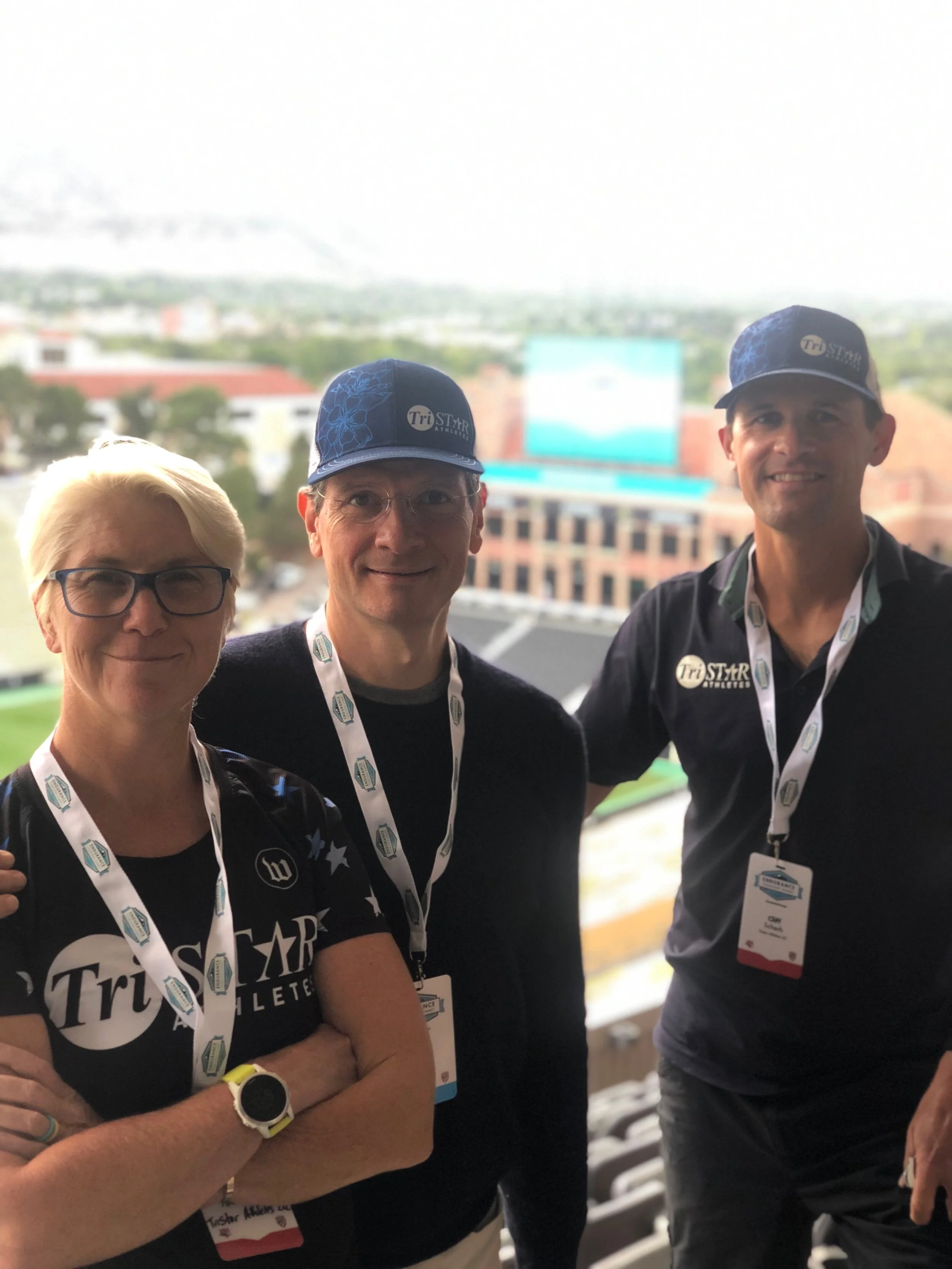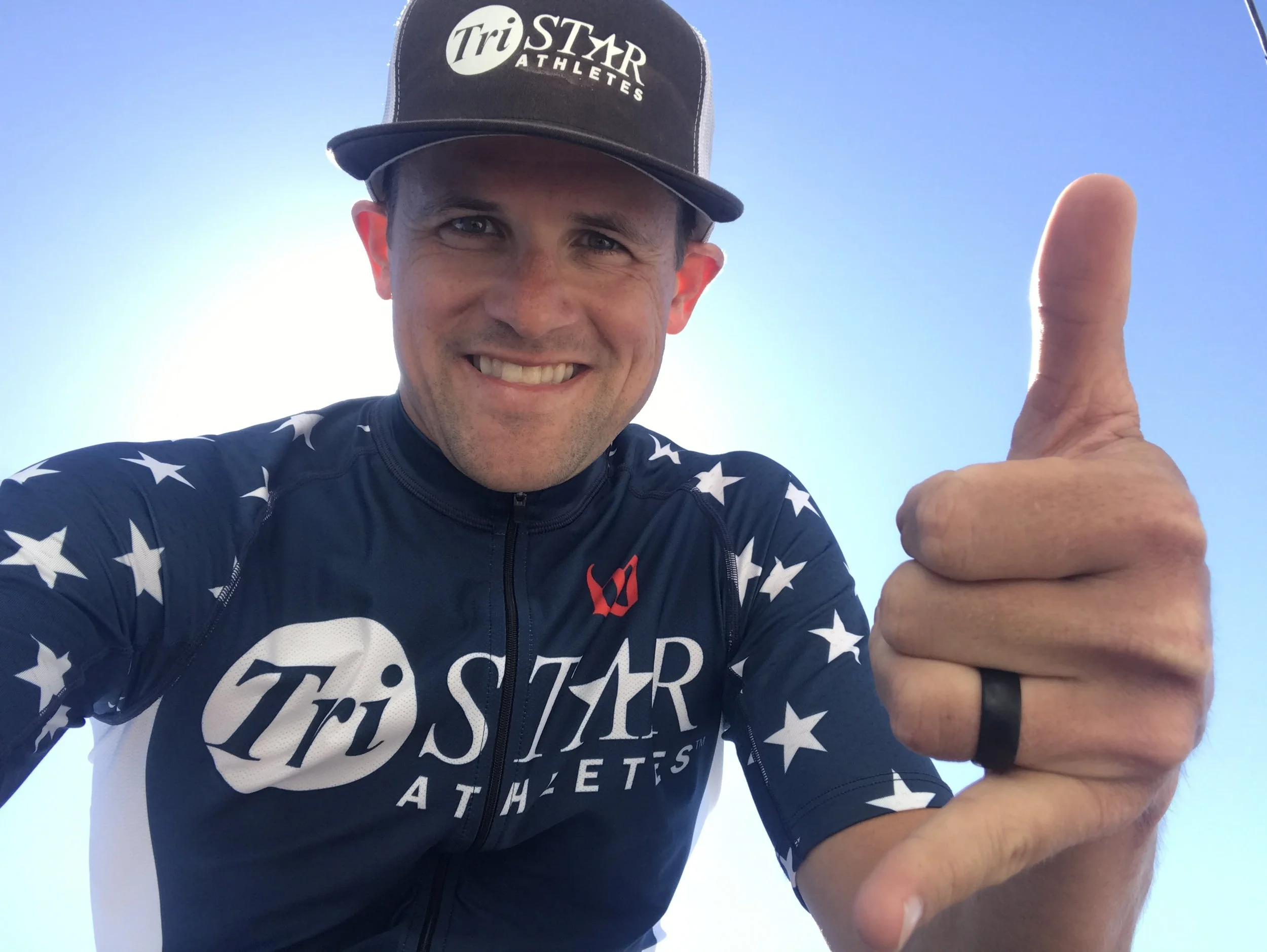Tristar athlete, one of the most important aspects of training that determines your overall output and Raceday ability is FTP; functional threshold power and pace. Our coaches detail how to improve this important metric on a monthly, annual and multi year time frame based on your ability.
FTP defined
For swimming; Functional threshold pace in swimming defined as a timed effort, where you swim as far as possible in a given time (e.g. 30 or 60 minutes). So, if you swim for 30 minutes and cover 1000 meters, then you can use the value of 33.3 m/min. as your FTP. Since the actual FTP is closer to the one-hour effort, it might be more advisable to perform a 60-minute test, or to take the value obtained for 30 minutes, multiply by two and subtract 2.5 percent.
For biking; You can estimate FTP with from your best recent 20-minute power value (either from a dedicated 20-minute test or a sufficiently hard 20-minute effort from a race or workout). Multiply that value by 95% to get your FTP.
For running ; Your Functional Threshold Pace will be the average pace from a recent race or very hard training run of 45-60 minutes in duration.
How to raise your FTP if you are a beginner endurance athlete “Ⓐ” ♥
Improve your aerobic capacity; You do not need to necessarily do threshold work to improve your FTP. Simply improving your base heart rate values and training in zone two in the base phases will improve your FTP. Newer endurance athletes will have limited ability to maintain power and pace over time without seeing a “ceiling” in their heart rate. As they train, the heart rate goes up dramatically even if the effort seems “easy”.
Longer rides and runs in heart rate zone two and three will get the job done in the early phases of training seeing watts and pace improve each month.
During key peaked out phases (Build I, Build II and Peak) that your coach is creating for you, will see improved muscular strength that will aid in your ability to raise FTP. (Endurance for time trialing) These sessions may actually be done in what we call the “sweet spot” , or just below the threshold to help stimulate your FTP to go higher.
Consistency; Our coaches will encourage you to be as consistent as possible as this is has the most impact on your fitness levels and once again FTP. Your continuous training load (How fit you are at any given time) marches up through the season as you train and when there are gaps in training the aerobic capacity may not improve enough to see substantive gains in the FTP.
Track workouts, hill repeats and high intensity interval training; These types of sessions will have more limited value for beginner endurance athletes and can be used sparingly during the final 6-2 weeks out from a peak event. Your coach will determine the total amount of intervals and intensity of these session based on how well your training is progressing.
Overall as a newer endurance athlete it is more critical to focus in on heart rate training to teach the body the proper physiology for raceday specificity than it is to hone in on the power and pace that the athlete would “like” to do on raceday.
Due to the heart rate decoupling (from limited aerobic capacity) newer endurance athletes will often times need to conduct their FTP tests pacing by heart rate and not power and pace.
Progression year over year of FTP
How to raise your FTP if you are an intermediate endurance athlete “Ⓑ” ♥+Ⓦ
Improve your aerobic capacity; Similar to beginner endurance athletes you won’t need to necessarily do threshold work to improve your FTP early on in your training. (Though if your fitness levels are starting off higher you may be able to do harder work straight away)
Simply improving your base heart rate values and training in zone two in the base phases will improve your FTP. As an intermediate endurance athlete you will start improving with heart rate zones two and three, power zones two and three and over the late stage build phases move towards exclusively training by power and pace with less emphasis on heart rate. The shorter mid week sessions will have little need for heart rate controlled work however the longer weekend sessions may have heart rate caps in conjunction with power and pace targets.
Longer rides and runs in heart rate zone two and three will get the job done in the early base phases of training, seeing watts and pace improve each month.
During key peaked out phases (Build I, Build II and Peak) your coach will be creating a plan that will see you having improved muscular strength that will aid in your ability to raise FTP. (Endurance for time trialing) These sessions may actually be done in what we call the “sweet spot” or just below the threshold to help stimulate your FTP to go higher.
Consistency; As an intermediate endurance athlete your total training hours and load will be higher and by default so too will be your your continuous training load (How fit you are at any given time) Because you are more consistent in training you will have an improved aerobic capacity which means you have the ability to train closer to your threshold with power and pace interval work.
Intensity factor; As an intermediate you also now have the ability to spend a higher time in the 80-100% range of FTP which helps move the dial in raising your FTP’s. You should strive to have the average intensity factor be in the 80% range and higher for shorter training sessions as you get closer to your peak and key races.
Track workouts, hill repeats and high intensity interval training; These types of sessions are extremely valuable in the final 10-2 weeks out from a peak event and will help to accelerate the raising of your FTP at this time. In fact these key weeks besides special off season work are your best timed opportunity to get faster. (Your coach will determine the total amount of intervals and intensity of these session based on how well your training is progressing.)
Overall as an intermediate endurance athlete it is more critical to focus in on heart rate in your initial training phases (Base I, Base II) to teach the body the proper physiology and then shift towards power and pace work with heart rate caps to “dial in” your FTP progression.
The training shift for intermediate endurance athletes is quite “seismic” in the fact that for the same heart rate, power and pace will dramatically improve over the course of a season heading towards a raceday peak.
How to raise your FTP if you are an advanced endurance athlete “Ⓒ” Ⓦ
Aerobic capacity; As an advanced endurance athlete you will be maintaining a higher level of training year round and thus your aerobic capacity is fully formed at nearly all times. This means that you can focus more exclusively on power and pace in your training throughout the season. Most seasoned athletes and elites/pro’s achieve this level.
Focused swimming biking and running at power and pace zones two and three will yield great results in building stamina that also subsequently builds your FTP.
To improve upon speed and FTP’s in general, year round you will need to train at and above your FTP periodically to improve.
Intensity factor; The intensity factor of these key threshold sessions will be based upon the phases of your training cycle and annual training plan. Meaning, early in the base phases you will need to do threshold work that has an overall intensity factor of 75% and less and at peak move towards an intensity factor of 85%+ for the main sets. Your coach will progress you through a sequenced and periodized approach to get your thresholds peaked out for your “A” priority races. When you raise the intensity factor in this way it brings the body into shape and peaks you out. It is a mistake to hit high intensity factor sessions in the base phase for these athletes though tune up races can help to check in on how things are progressing early on in the season.
During key peaked out phases (Build I, Build II and Peak) your coach will be creating a plan that will see you having improved muscular strength that will aid in your ability to raise FTP. (Endurance for time trialing) These sessions may actually be done in what we call the “sweet spot” or just below the threshold to help stimulate your FTP to go higher.
Consistency; It is assumed you have a higher total training load that supports a superior aerobic level of fitness. (To learn more if you are at this level follow here)
Intensity factor; As an advanced endurance athlete you have the ability to spend a higher time in the 95-170% range of FTP which helps move the dial in raising your FTP’s. You should strive to have the average intensity factor be in the 85% range and higher for shorter training sessions as you get closer to your peak and key races.
Track workouts, hill repeats and high intensity interval training; These types of sessions are extremely valuable in the final 15-2 weeks out from a peak event and will help to accelerate the raising of your FTP at this time. In fact these key weeks besides special off season work are your best timed opportunity to get faster. (Your coach will determine the total amount of intervals and intensity of these session based on how well your training is progressing.)
Overall as an advanced endurance athlete it is important to focus in on pace and power in all of your training phases to get faster and stronger. Heart rate will have very limited value for pacing and even raising FTP. It is not uncommon for elite level Tristars to be at their FTP’s for both pace and power and find that their heart rate is only in zone three and for some only zone two!
Training sessions that raise FTP
“Sweet spot” training sessions done at 89-95% of FTP
Heart rate training at 98-102% of LTHR (lactate threshold heart rate).
Hill repetitions for both the bike and run (These are threshold work in disguise even when done at a moderate effort as they recruit more muscles and enhanced training stamina. They may be done for heart rate or power and pace.)
Track workouts and speed sessions on the run.
Group rides
Racing ~30-90minute events that are done just below or above FTP.
Tempo intervals 80-93% of FTP lasting 20-60minutes with minimal stop and rest time.
Very hard intervals done at 100-105% of FTP
Longer endurance rides and runs even at low intensity.
Any training session that is longer and or hard than the body has seen before….!
Physiological Testing
Metabolic Cart testing or lactate threshold testing is a common and great way to learn about your unique training physiology. We at Tristar Athletes feel that these tests can often times be expensive and need the help of a skilled technician making them less valuable on a regular basis.
We always learn something from these tests however field testing tells us nearly all we need to know about your FTP’s and heart rate zone values.
Metabolic cart testing can have value if you are fuel limited for longer course endurance races where fat burning vs carbohydrate burning values matter. Ask your Tristar Atheltes coach if this is something of value to you and your training.
A metabolic cart test can tell you more detailed information about your fuel mix utilization and therefore can enhance you dietary needs and how you feed your body. Your tristar coach may recommend this test in conjunction with a Tristar nutrition plan.
Blood lactate testing; drawing blood during a field test can reveal the point at which your threshold heart rate exists. Knowing this value can help to dial in you heart rate values which can be determined from a raceday performance as well. We use this type of testing more rarely even though the information is interesting; it is not a necessity.
Limits to FTP and when FTP goes down
There are limits to how much the FTP can grow in one cycle, and season. Multi year planning is necessary for longer term race goals.
FTP will grow more slowly in the base phases and more quickly in the build phases.
Off season work is neccessary for hungry athletes to improve for next season. The main reason is that is allows the athlete to focus in on a single sports FTP. (For instance the run FTP lags the bike FTP and to grow this athlete may need to work more exclusively on their run in the off season and not bike as much)
Most athletes can lock into peaked out FTP phase for only 8 weeks. This should be timed around key races and events as well as timed with key total fitness levels.
During the off season and downtime FTP is expected to and will go down. This is a normal part of the up and down cycles of training. The key is to reset a new base “bottom” that is still above pervious FTP off season values so that the total size of the FTP motor continues to grow. It is this main reason why endurance athletes continue to improve year after year raising their race-day potential which takes time.
Your Tristar Coach will lower and raise your FTP’s throughout your season based upon your performances and data. It is critical to adjust these thresholds downwards to accommodate a loss of fitness and ongoing so that training is not amplified and too hard on the body.
Health and recovery; Often times the limits to how high one can raise their FTP depends upon how fast you as an athlete can recover. If you are not sleeping enough and or nutrition is off then you may miss more regular opportunities to perform at or above threshold. Learn more about what it means to “not be able to perform” and what to do when you FTP is not improving.
Age and FTP
Your swim FTP can constantly go upwards even to later stages in your endurance age and career. Form is a bigger limiter for most endurance athletes vs age.
Cycling FTP can also go up and continue to elevate up in to your early 50’s as an athlete. Due to the muscular nature of cycling you can have a very strong and elevated career!
Run FTP has a larger “age” adjusted growth rate. As we get older and lose our VO2 Max total FTP speed will also decline. The goal of consistency in running is more important to maintain what you have created and not erode your FTP. Periods of downtime and no running have the largest impact on FTP at older ages.
Peak power and pace curves to raise FTP
The infographic below details an Atheltes peak power curve and shows their personal critical power bests from one season to the next (Critical power = mean max output for a given time duration)
Using your peak power curve you can identify various peak powers you have sustained in the past and present. When you improve upon any point in the continuum of your chart you improve that representative energy system. For example; if you want to raise your FTP (60min time trial ability) you may opt to time trial and raise your power at 90minutes and up to two hours. By raising the points on either side of your FTP you stimulate it to go higher.
The same holds true for any point you are trying to improve for example if you are looking to raise your VO2 max power (5min power or pace output) You may try to improve your critical pace and power at 2minutes and 10minutes.
Thats a wrap! …and the 411 on FTP. For more information or questions specific to your training and plan please reach out to your Tristar Coach to help answer questions. Train hard… and SMART!
~The Tristar Athletes Coaches 👨🏻💻

















